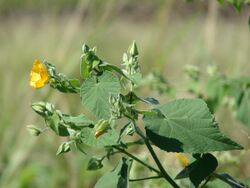Biology:Abutilon grandifolium
| Abutilon grandifolium | |
|---|---|

| |
| Scientific classification | |
| Kingdom: | Plantae |
| Clade: | Tracheophytes |
| Clade: | Angiosperms |
| Clade: | Eudicots |
| Clade: | Rosids |
| Order: | Malvales |
| Family: | Malvaceae |
| Genus: | Abutilon |
| Species: | A. grandifolium
|
| Binomial name | |
| Abutilon grandifolium | |
Abutilon grandifolium, the hairy Indian mallow, is a large shrub that is up to 3 m (9.8 ft) high with broad, 3–18 cm (1.2–7.1 in) leaf blades. Flowers are axillary, with a yellow corolla 2–3.5 cm (0.8–1.4 in) across, composed of petals 1–1.5 cm (0.4–0.6 in) long. The fruits are ovoid-globular schizocarps that are 1–1.5 cm (0.4–0.6 in) in diameter and composed of ten shortly beaked mericarps, containing 2-3 seeds each.[1]
A. grandifolium can be distinguished from A. theophrasti by long, simple hairs on the stem rather than stellate hairs.
Distribution
The species is native to tropical America[1] and Central and South Africa,[2] but it is naturalised in other parts of the world, including the Canary Islands, Hawaii, and throughout shrubland and loamy areas of Australia . In Western Australia, it is found in the Swan Coastal Plain.[3] Due to this species’ prolific seed production and propensity to spread, A. grandifolium is considered an invasive species in some of the regions where it grows, becoming a problematic weed in riparian zones, grasslands, and tall shrubland ecosystems throughout the world. In Hawaii, it is reported as having a detrimental effect on Spermolepis hawaiiensis and Scaevola coriacea, two endangered and threatened plant species.[4]
Threat level
A. grandifolium is considered an invasive or potentially invasive weed in Micronesia, Hawaii, Portugal, South Africa , and in parts of Australia (particularly southeastern Queensland and eastern New South Wales),[5] and is not considered a threatened species.[3]
References
- ↑ 1.0 1.1 1.2 "Abutilon grandifolium", Flora of Pakistan, http://www.efloras.org/florataxon.aspx?flora_id=5&taxon_id=242412002, retrieved 15 October 2015
- ↑ Bailey, L.H. and E.Z. Bailey, Hortus Third: A Concise Dictionary of Plants Cultivated in the United States and Canada, MacMillan Publishing Co., Inc., New York , (1977).
- ↑ 3.0 3.1 "Abutilon grandifolium (Willd.) Sweet". FloraBase. http://florabase.calm.wa.gov.au/browse/profile/19708.
- ↑ "Abutilon grandifolium (hairy Indian mallow)". https://www.cabi.org/isc/datasheet/111972#tosummaryOfInvasiveness.
- ↑ "Abutilon grandifolium (hairy Indian mallow)" (in en). https://www.cabi.org/isc/datasheet/111972.
External links
| Wikimedia Commons has media related to Abutilon grandifolium. |
- Abutilon grandifolium information from the Hawaiian Ecosystems at Risk project (HEAR)
- Abutilon grandifolium in the Canary Islands
- Abutilon grandiflorum in Flowering Plants of Africa 64: 76–83 (2015).
Wikidata ☰ Q280892 entry
 |

